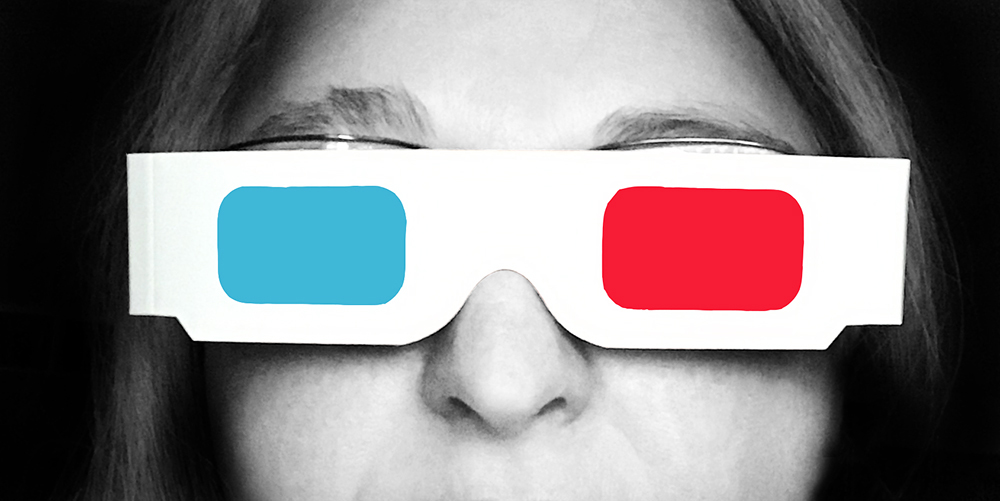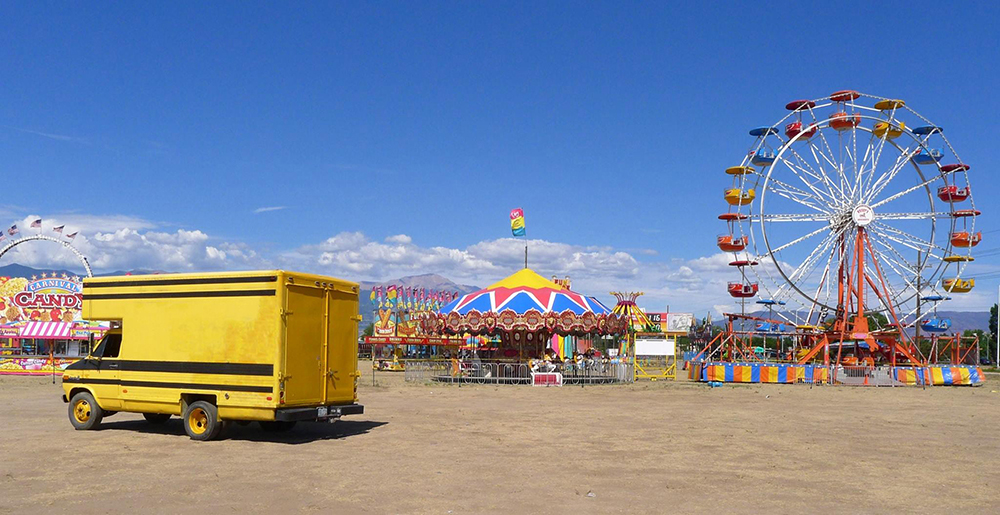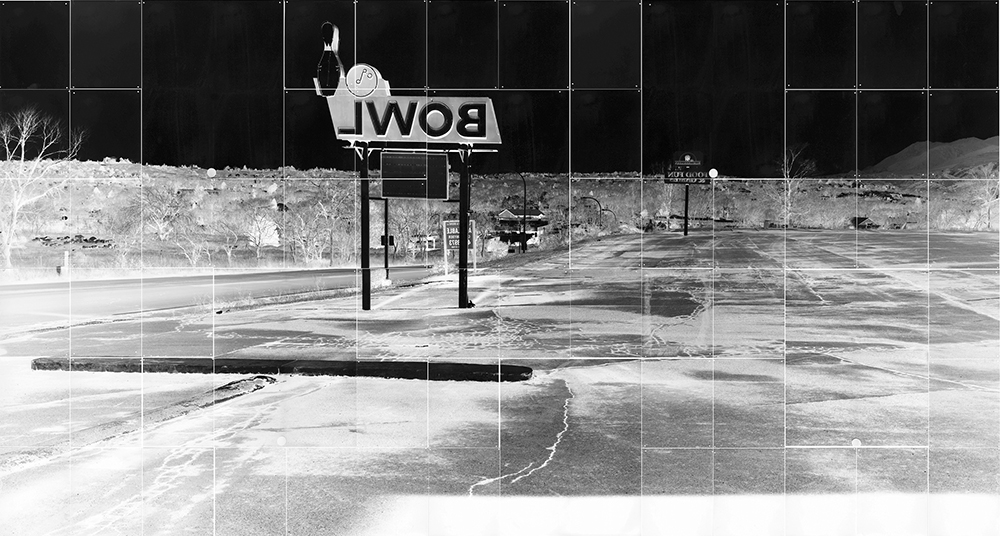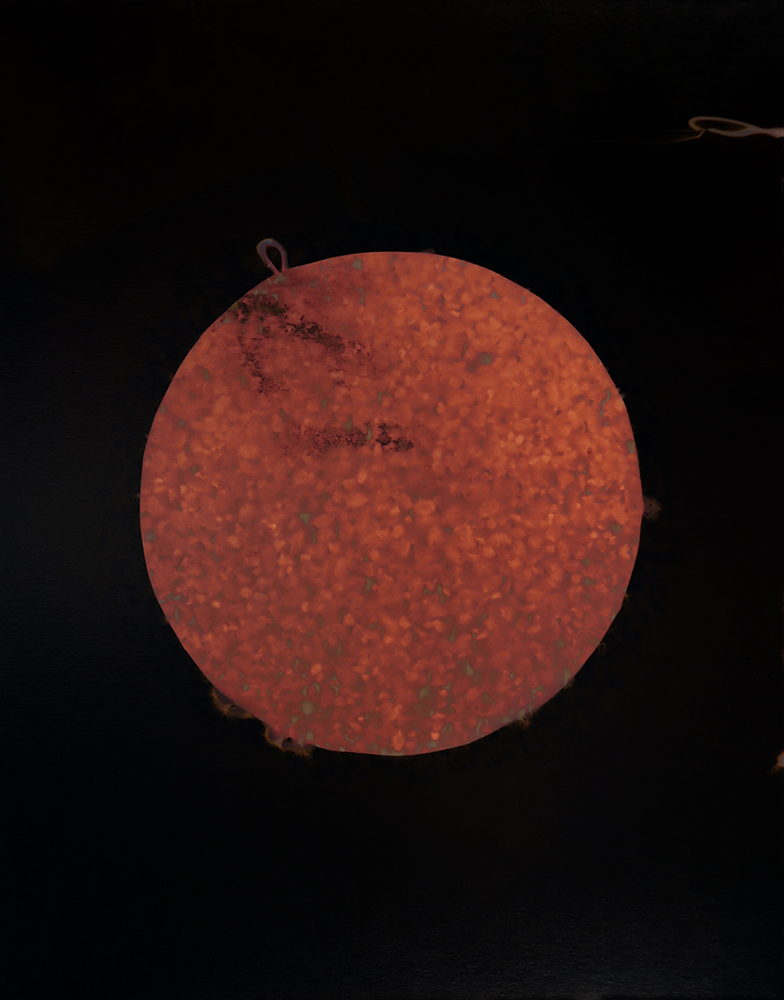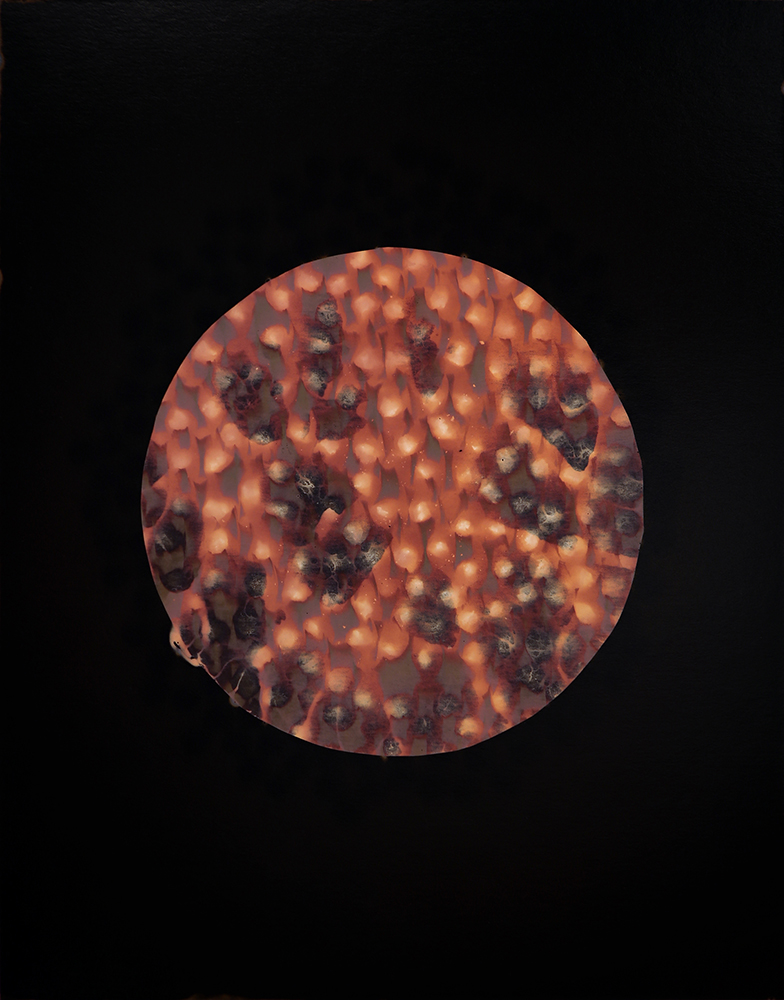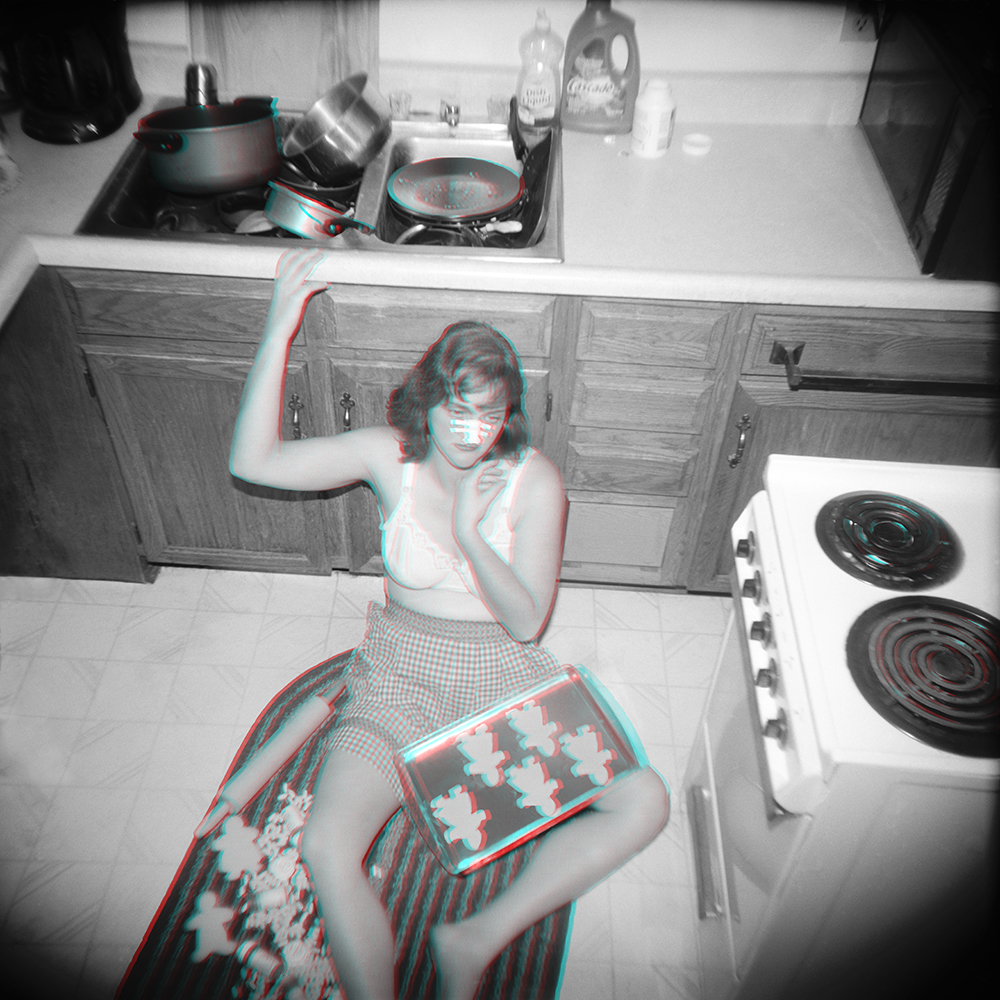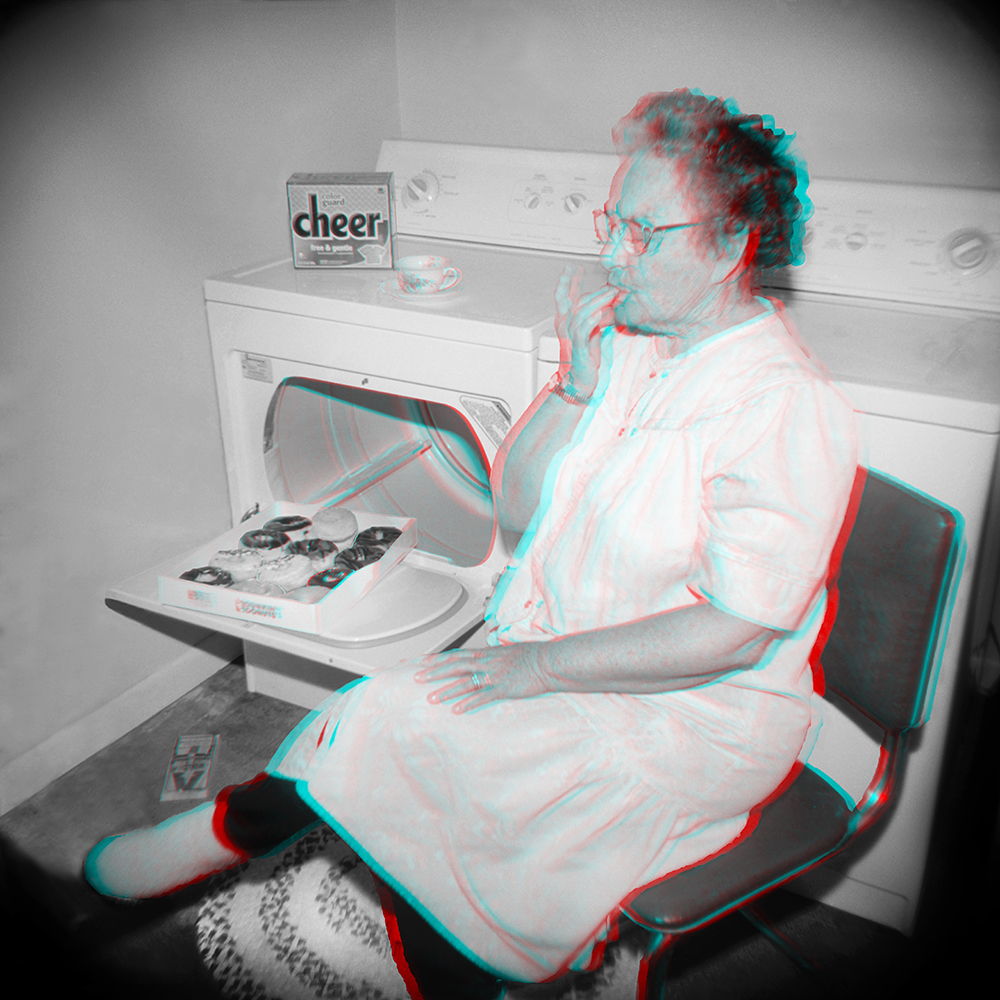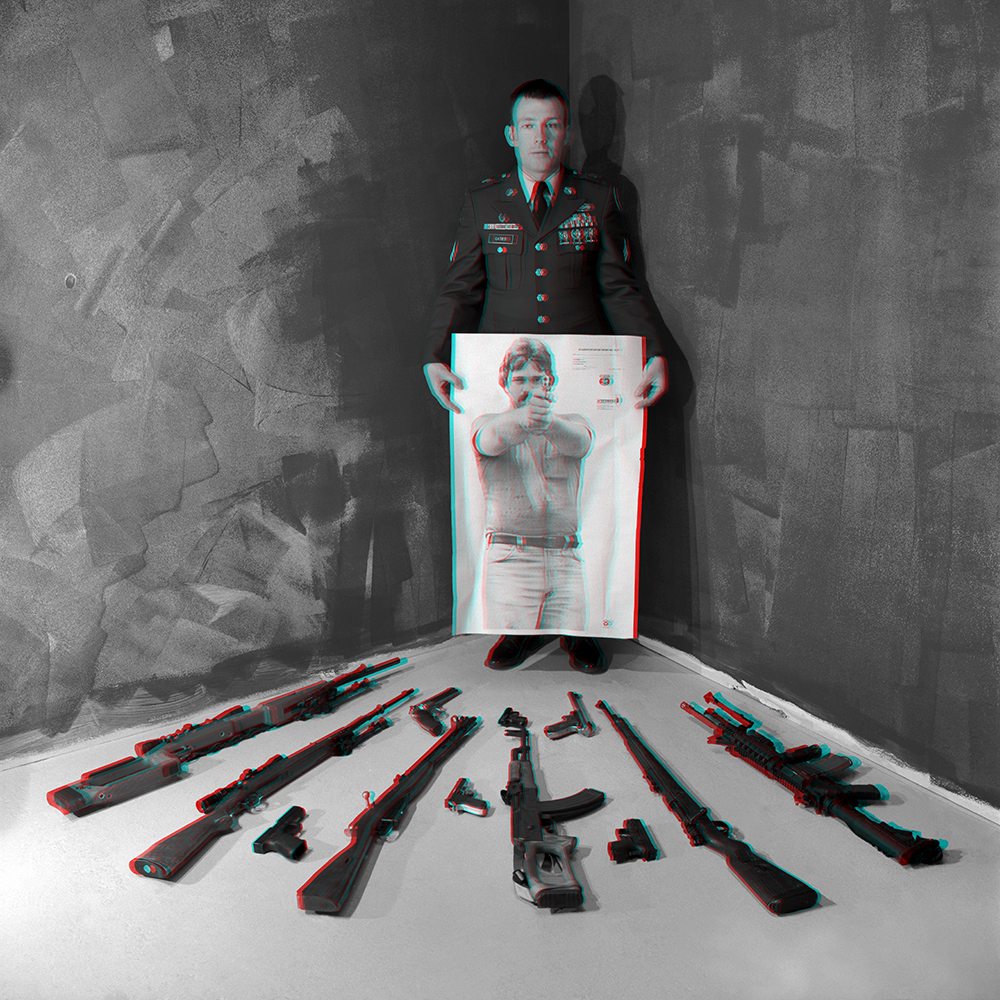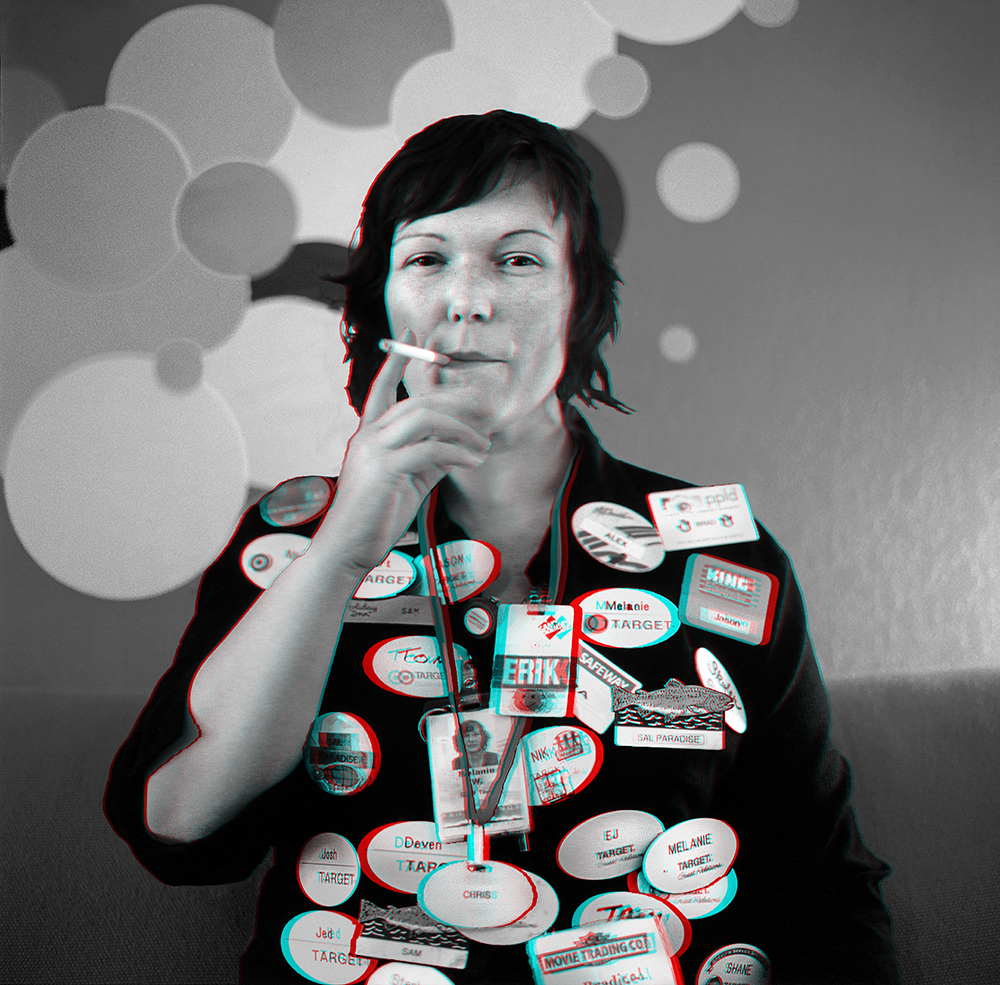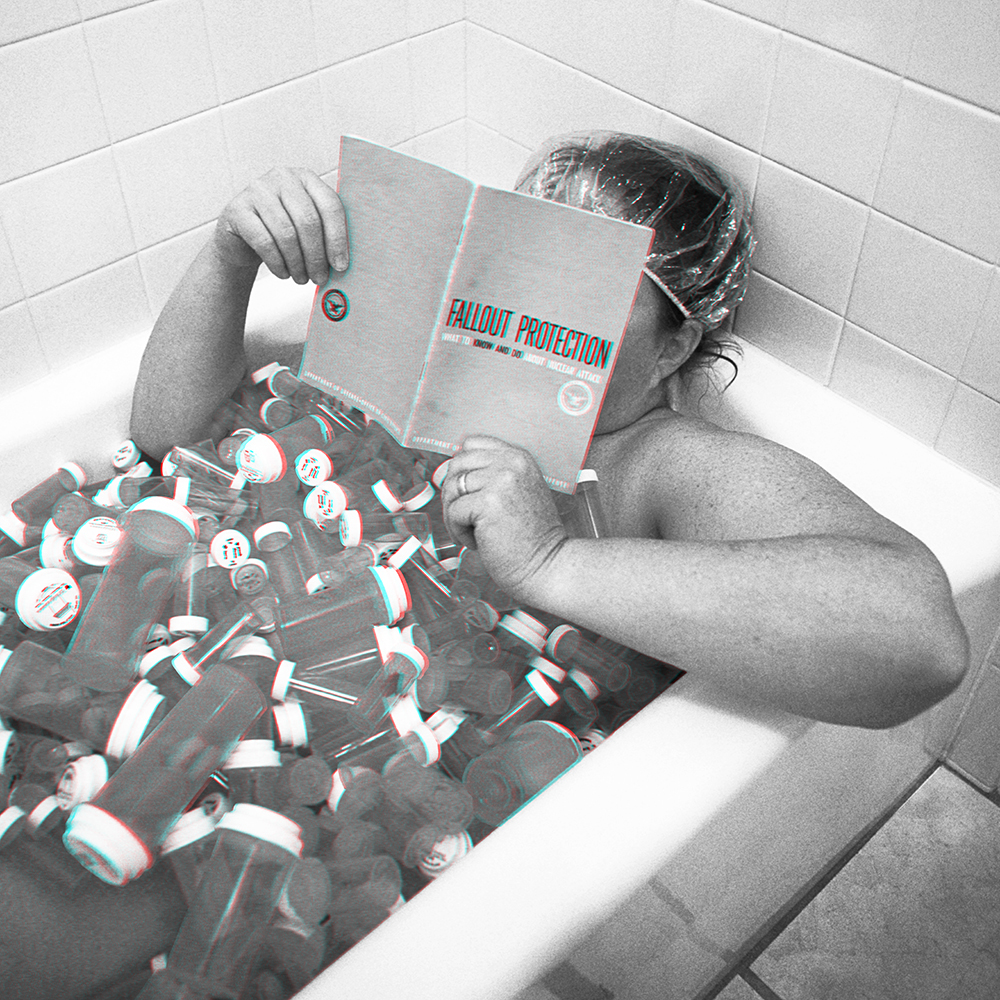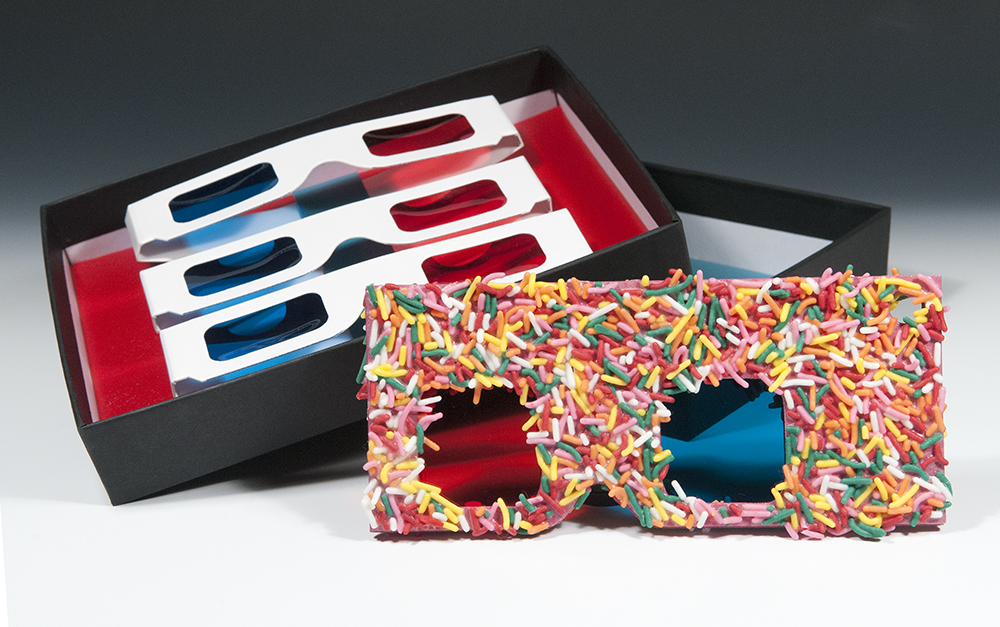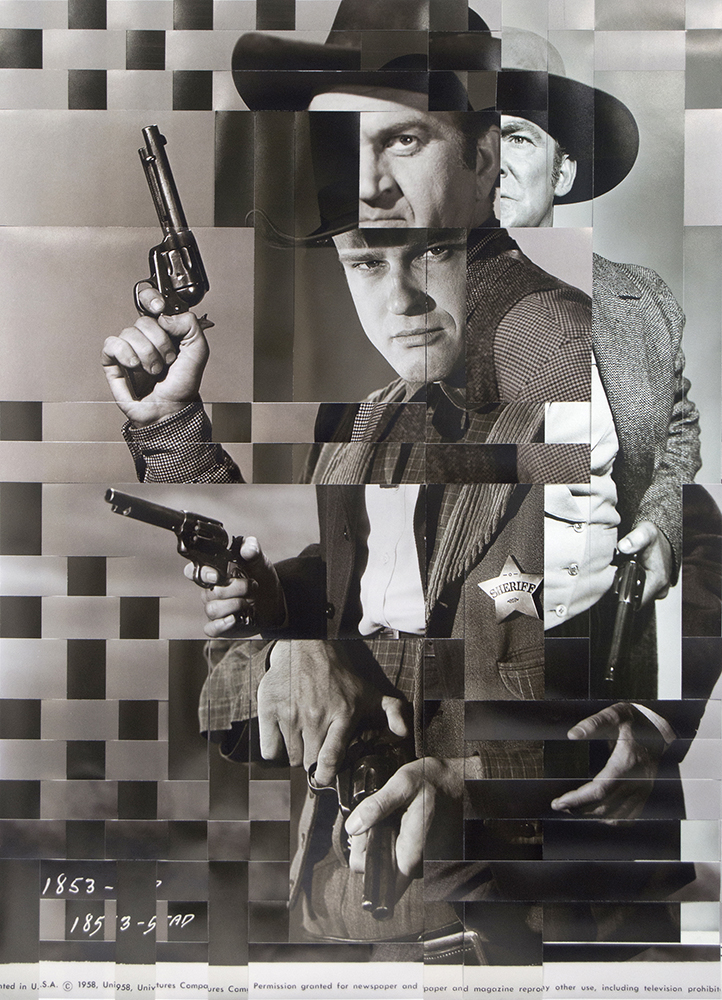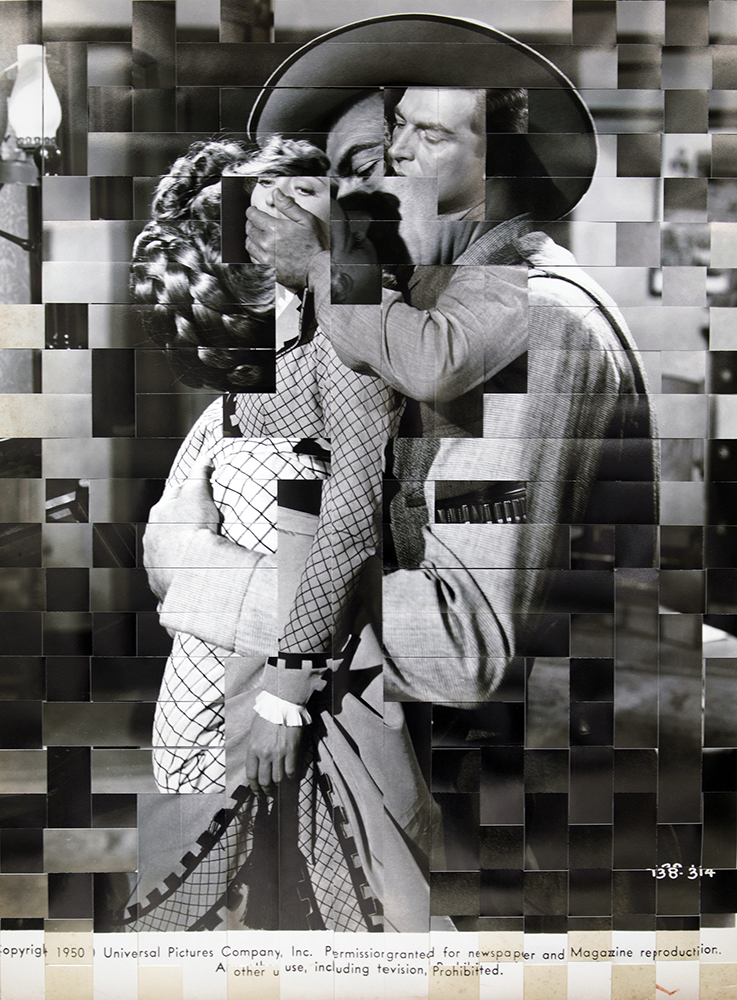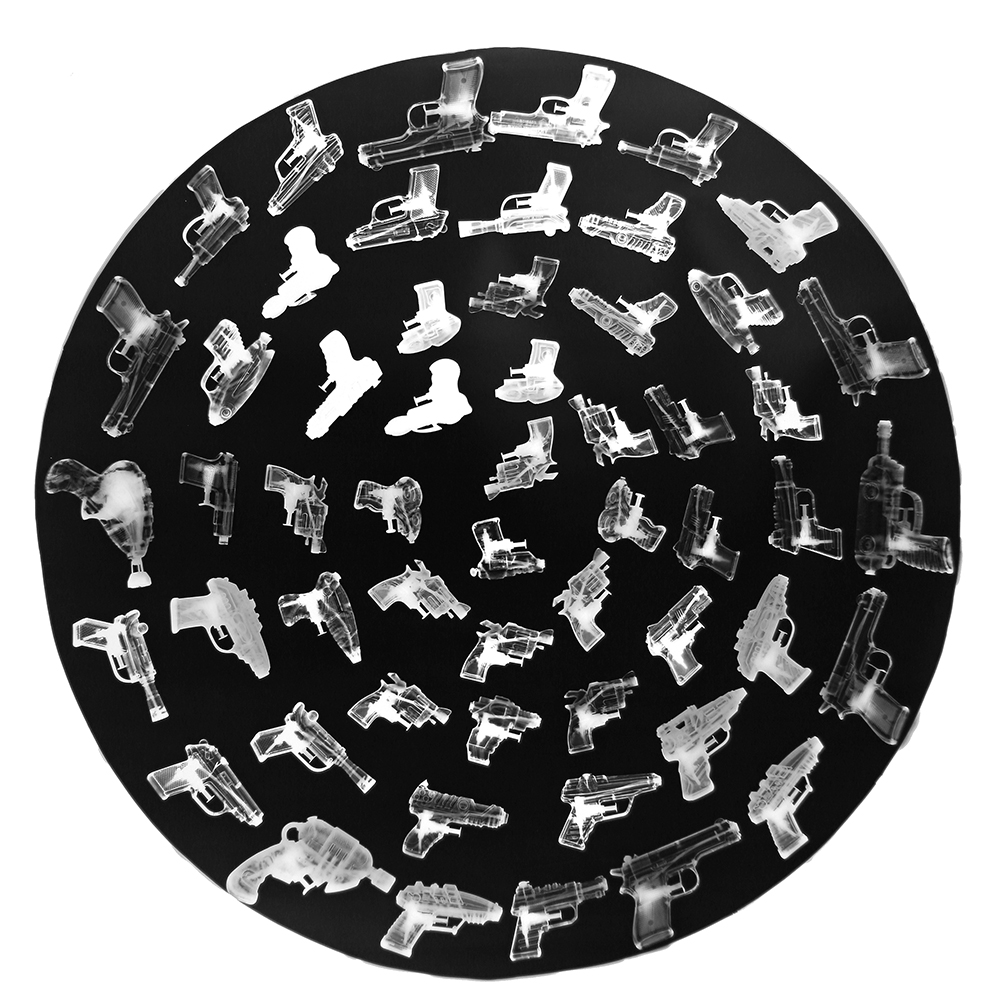Heather Oelklaus by Christa Blackwood
Photographers on Photographers: Christa Blackwood and Heather Oelklaus
I was a secret lurking fan of Heather Oelklaus’ brilliant work for several years before I met her in the Fall of 2014 at Colorado College in Colorado Springs. Before we met, I knew her only by her internet nom de plume, “Camera Karma,” and I was immediately drawn to her work that melds tediously technical and arduous historical photographic techniques with slyly subversive and humorous concepts. My daughter, Cecil, was checking out schools in Colorado for her undergraduate degree, and I knew from Heather’s Facebook profile that she worked at the art department at Colorado College. I eventually mustered up the courage to send this alt-pro-goddess a message on Facebook to tell her that we would be visiting Colorado College for a campus tour, and that we would love to meet her if at all possible. I was delighted when she quickly and enthusiastically responded and said that she’d love to give us a tour of the art department, and to take us to lunch on campus-score! Over the years Heather has become one of my dear friends and close colleagues, and my admiration for her and her work has grown exponentially. I was thrilled to be given the opportunity to ask her a few questions about her photographic work, as well as where she drew inspiration from for her most recent series, Anaglyph.
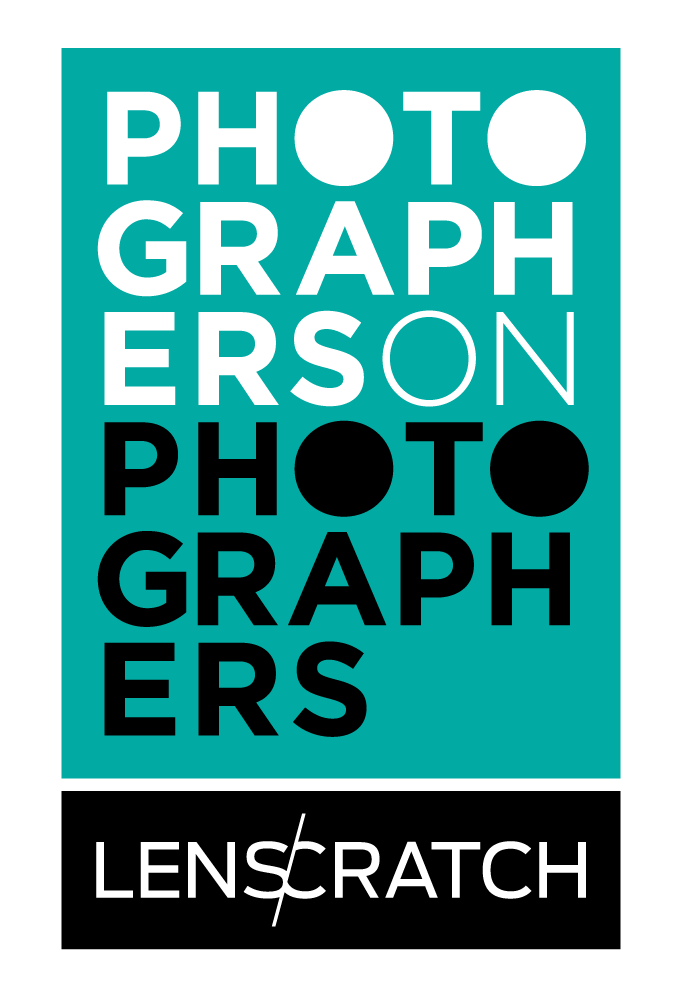 Heather Oelklaus (b. 1972, USA) studied Sculpture at The Kansas City Art Institute (KCAI) in the early 1990s. She has exhibited work in solo and group shows in Colorado, New Orleans, Oregon, New York, Texas, and Arizona. Heather creates in Colorado Springs where she explores a variety of art making. Photography as an object instead of the traditional reproduced image influences Heather’s art with themes of family, social and gender roles, and abstract art. The viewer’s experience is just as important as the image itself, she encourages you to take your time.
Heather Oelklaus (b. 1972, USA) studied Sculpture at The Kansas City Art Institute (KCAI) in the early 1990s. She has exhibited work in solo and group shows in Colorado, New Orleans, Oregon, New York, Texas, and Arizona. Heather creates in Colorado Springs where she explores a variety of art making. Photography as an object instead of the traditional reproduced image influences Heather’s art with themes of family, social and gender roles, and abstract art. The viewer’s experience is just as important as the image itself, she encourages you to take your time.
Christa Blackwood: There’s a wondrous sense of playfulness and irony in your work that highlights re-occurring subjects with themes — kitsch, gender, Americana and Hollywood in the 50’s, cowboys, housewives, doctors/nurses, guns and even kiddy breakfast cereals — How did you get here? Where did you grow up? Did you always know that you were going to be a visual artist?
©Heather Oelklaus, “Bowl” // SixtyTwo Silver Gelatin Prints // 2015// Taken with the pinhole camera truck, Little Miss Sunshine
Heather Oelklaus: My upbringing in a small Iowa town has influenced my conceptual direction over the years. My imagination has always been vivid and hearing family members’ stories while I was young was a delight.
Heather Oelklaus: Stories that took place during a time where people trusted one another, played high school pranks, had small town childhood freedom, and roles that were always being challenged sent my mind reeling. I was proud to have a Great Grandmother that left her husband after the first time he hit her. The courage to do that in the early 1950’s seemed like a sort of super power in my fertile mind. Cereal, Spam, cowboys, housewives, black and white photography with staged sharp imagery, and ideals of family roles made their way into my work throughout the years. When asked what I wanted to be when I grew up I always said “artist” and never even considered any other option. The ego is a powerful influence. I remember being sick with a high fever when I was ten years old. I had drawn a picture of Mickey Mouse and my Mother was really impressed. When I think back about that moment I visualize it as a lightning bolt marking the time I knew I was going to be an artist.
CB: Can you tell us about your most recent series, Anaglyph? What is the inspiration behind the 3-D work?
HO: The inspiration for this new body of work is my old body of work. The images were first introduced in the “Better Homes & Icons” Series back when I was a young Mother. Each image was shot on film and highly staged with each object chosen for their metaphor. Inspiration hit while I was cleaning dishes, cooking dinner, shopping for groceries, and changing diapers. These domestic times, quiet times, sometimes lonely times pushed me to express my feelings.
The series did not get shown as much as I would like and time sped by with new interests and inspirations. The older my daughter got, the more distant I felt from those ideas I had expressed in the “Better Home & Icons” series. Now, 15 years later, I have grown disconnected with photography or at least what my idea of what photography means to me. Going back and examining my old work lit a fire and I searched for a way to make people see what I was showing them with the objects as metaphor in the staged scenes. I long for the viewer to take the time to see what I am saying. In a world where virtual reality is growing in leaps and bounds, my answer to capturing the fleeting attention of the viewer is to make the objects in the staged photographs jump off the surface of the image. This analog version of virtual reality is a delight to viewers. It is approachable and gives the audience their own experience with each work of art. To be able to provide this solitary time while sneaking in a message is what I have always wanted to accomplish with these photographs. The anaglyph series is small with editions of five. Special edition collector’s 3D glasses accompany each work of art sold within the series. The glasses go hand in hand with the visual narrative of the work. “Dirty Laundry, Anaglyph” portrays a woman delighting in a snack in the only place where no one will find her stash of sprinkled doughnuts; so the collector’s glasses I made for this image is made out of sprinkles. I have also made glasses out of sugar cookie, pill bottle plexiglass, blue satin, wood, and a Tide laundry detergent box.
CB: It’s such a joy to see someone that has mastered so many historical photographic techniques — tintypes, daguerreotypes, ginormous silver prints, lumens, cyanotypes, hand made pinhole cameras made from everyday objects — and to see these processes fused with contemporary ideas and humor. What typically comes first to you, the idea behind the work or the process/technique?
HO: Concepts hold a priority in my studio practice. It makes little sense to me to want to do a process and THEN try to come up with an idea solely to use that technique. My process is similar to getting ready for a party….you must accessorize! The concept is the party and the accessory is the technique. They must go hand in hand. They must go together. When I have an idea for a piece or body of work, if it is best translated through a kinetic sculpture, then I will learn how to create kinetic sculptures. There are no bounds to my work, I never want to be stopped by sticking to just one way of expressing myself.
The countdown begins! 📷 In celebration of Worldwide Pinhole Photography Day on April 30th, I’ll be sharing my favorite handmade pinhole cameras and images with you every day this week. Join me on this journey as I share my personal history with pinhole photography ! ✨.
I have been in awe of Jo Babcock over the years. His humorous camera and image combinations pushed me to explore how the vessels used to photograph can be just as meaningful as the photos they create. This teapot camera was one of my first attempts at making my own cameras.
1…Teapot Pinhole Camera made in 2015
2…»Tea Time», 16″ × 16″ contact print on Ilford RC Pearl Silver Gelatin.
3. Video of Teapot camera being taken out of the China cabinet. Time to give her a good polish. #heatheroelklaus #pinholephotography #wwppd #pinholecamera #homemadecamera #papernegative #blackandwhitephotography #teapot #analogphotography #silvergelatin #WWPPD #pinholephotography #countdowntoWPPD #teatime #darkroom #wppd
Day 2 of my countdown to Worldwide Pinhole Photography Day. I’m sharing my pinhole camera that I used to capture a kaleidoscopic thrill ride inspired by the classic movie «Jaws». It’s a Kodak movie film can with multiple pinholes. To get this shot, I preloaded the camera with a circular paper negative and headed to Port Aransas, TX to meet up with the @shootapalooza bunch. If you haven’t heard of them, you should definitely give it a google and discover a group of passionate photographers that have formed a community under the founding late and great, Judy Sherrod.❤️
With this preloaded cinematic film can in hand, I headed to one of the tourist stores that had an entrance way made to be the mouth of the great white shark. It was such a fun experience walking through shark and getting swallowed up by this larger than life «tourist trap». I found a brick to prop up the camera and placed it about 10 feet from the mouth. In my car, I quickly took off all the taped shutters and placed a coat over the opened apertures. I ran to the brick and placed the camera down and exposed it for 45 seconds, all the while hoping that I had the exposure right.
Once the exposure was completed, I quickly threw my coat back over the holes, and I noticed two guys approaching. They must have been confused by my pinhole adventure that morning, and I took the opportunity to spread the joys of Pinhole Photography to these dudes. I went on and on about what I was doing and hoping to achieve, and they nodded along as I spoke. But when I finished, they asked, «But where are you from?» I replied «Colorado», and their eyes lit up as they asked, «You got any weed?».
1….»Galeophobia», 18″ × 18″ contact print on Ilford RC Pearl Silver Gelatin Print, 2015
2…homemade 9 pinhole camera made from an Eastman Kodak Motion Picture Film Can.
3…making the exposure.
4….me wearing my Liquid Image Digital Underwater Camera Mask after the pinhole shoot. If you’re going to be in the mouth of a shark, I figured this would be the right camera for the job. #heatheroelklaus #worldwidepinholephotographyday #pinholephotography #wwppd #countdowntowppd #portaransas #galeophobia #multipinhole #homemadecamera #wppd
Día 2 de mi cuenta regresiva para el Día Mundial de la Fotografía Estenopeica. Estoy compartiendo mi cámara estenopeica que usé para capturar un emocionante viaje caleidoscópico inspirado en la película clásica «Tiburón». Es una lata de película Kodak con múltiples orificios. Para tomar esta foto, precargué la cámara con un negativo de papel circular y me dirigí a Port Aransas, TX para reunirme con el grupo @shootapalooza. Si no has oído hablar de ellos, definitivamente deberías buscar en Google y descubrir un grupo de fotógrafos apasionados que han formado una comunidad bajo la fallida y grandiosa fundación Judy Sherrod.❤️
Con esta película cinematográfica precargada en la mano, me dirigí a una de las tiendas para turistas que tenía una entrada hecha para ser la boca del gran tiburón blanco. Fue una experiencia muy divertida caminar entre tiburones y dejarse tragar por esta «trampa para turistas» más grande que la vida. Encontré un ladrillo para sostener la cámara y lo coloqué a unos 10 pies de la boca. En mi auto, rápidamente quité todas las contraventanas selladas y coloqué una capa sobre las aberturas abiertas. Corrí hacia el ladrillo, coloqué la cámara y la expuse durante 45 segundos, esperando en todo momento tener la exposición correcta.
Una vez que se completó la exposición, rápidamente tiré mi abrigo sobre los agujeros y noté que dos tipos se acercaban. Debieron estar confundidos por mi aventura estenopeica de esa mañana, y aproveché la oportunidad para compartirles los placeres de la fotografía estenopeica. Seguí y hablé sobre lo que estaba haciendo y lo que esperaba lograr, y ellos asintieron mientras hablaba. Pero cuando terminé me preguntaron: «¿Pero de dónde eres?». Respondí «Colorado» y sus ojos se iluminaron cuando preguntaron: «¿Tienes hierba?».
1….»Galeofobia», impresión de contacto de 18″ × 18″ en Ilford RC Pearl Silver Gelatin Print, 2015
2… cámara estenopeica casera de 9 orificios hecha con una lata de película cinematográfica Eastman Kodak.
3…haciendo la exposición.
4… yo usando mi máscara de cámara subacuática digital Liquid Image después de la sesión estenopeica. Si vas a estar en la boca de un tiburón, pensé que esta sería la cámara adecuada para el trabajo. #heatheroelklaus #worldwidepinholephotographyday #pinholephotography #wwppd #countdowntowppd #portaransas #galeophobia #multipinhole #homemadecamera #wppd
Día 3 de la cuenta atrás para el Día Mundial de la Fotografía Estenopeica. La inspiración para esta cámara surgió de mi experiencia en la reunión Shootapalooza en Port Arkansas, Texas, donde transformé un carrito de equipaje en una cámara oscura y llevé a los miembros del club a dar una vuelta por el estacionamiento del hotel.
Después de regresar a casa, me vi obligado a crear mi propia cámara multiorificio a partir de un carrito de botones. Las imágenes resultantes están estratificadas, distorsionadas y extrañas, y reflejan las complejidades emocionales y las profundidades ocultas de la psique humana. Me propuse fotografiar “mi equipaje”. Una de esas imágenes es «Otherside», una impresión de doble contacto en papel de gelatina Ilford RC Pearl Silver utilizando la cámara del carrito de botones.
A través de mi trabajo, pretendo desafiar las nociones tradicionales de la fotografía y el papel de la cámara como herramienta para capturar la realidad objetiva. En cambio, busco utilizar la cámara como un medio para explorar la experiencia subjetiva y las verdades ocultas que se encuentran debajo de la superficie. Mi instalación en la Galería Coburn, con «Otherside» y «Quake», fue parte de la exposición «Staging: Constructed Realities, Altered Worlds», donde invito a los espectadores a considerar el bagaje psicológico que todos cargamos y las formas en que éste da forma. nuestra percepción del mundo.
1 y 2…La cámara del botones en el campo
3…“Terremoto”, 49″ x 24″, 2015
4…“Otro lado”, 49″ x 24″,2015. Doble exposición durante la impresión por contacto en papel de gelatina Ilford RC Pearl Silver
5…Vista de instalación de la cámara Bellhop con “Otherside” y “Quake” durante la exposición “Staging: Constructed Realities, Altered Worlds”, Coburn Gallery, Colorado Springs, CO 2016
6…Carrito de botones con cámara oscura en el estacionamiento del hotel. Hay alguien dentro del carro. 🔈 Sube el volumen para escuchar a Judy Sherrod reír. ❤️
#heatheroelklaus #countdowntowppd #pinhole #pinholecamera #bellhop #photography #wppd #iwasraisedquaker #itmakessensenow #baggage #contactprint #papernegative
https://www.instagram.com/p/CrecOsTMdN9/?img_index=1
Día 4 de mi cuenta regresiva para el Día Mundial de la Fotografía Estenopeica. Esta cámara es un simple tubo estenopeico… un tubo ENORME. Tan grande que tuve que ponerlo sobre ruedas para jardineras. Para cargar este monstruo tienes que sumergirte en él y usar imanes para colocar el papel fotográfico @ilfordphoto en la curva. Es todo un esfuerzo físico, pero vale la pena conseguir una distorsión curva tan maravillosa. Cuando uso esta cámara digo que estoy «disparando la curva». La apertura es f489 y la mayoría de las exposiciones tardan 4 minutos en un día soleado. En la foto se muestran una variedad de imágenes de prueba y muchas de WPPD 2019 cuando lo llevé a Denver para el evento estenopeico @cpacphoto. Gracias a todos los que habéis posado para mí. ¡Haces que esto sea muy divertido! @bentimpson @trinaamcam @trollinthrdungeon @jamesreiman #heatheroelklaus #pinholephotography #wppd #countdowntowppd #homemadecamera #shootinthetube #ilfordphoto #papernegative
Día 5 de mi #countdowntowppd y debo volver a visitar mi aventura del día estenopeico del año pasado. Esta es mi primera cámara que diseñé e imprimí en 3D. Es una cámara estenopeica múltiple de película 4×5 (pero prefiero usar #papernegatives). Utilicé @shapr3dapp para diseñar… ese es el vídeo en pantalla en la última diapositiva. Lo imprimí con pla en mi #ender3. Mi musa era Jeff y las vallas blancas. Pensé que la idea de múltiples vallas dentro de una casa trae una sensación de nostalgia al comentar sobre el idealismo percibido. #heatheroelklaus #wppd #pinhole #nostalgia #whitepicketfence #wppd2022 #house #modelhouse #3dprinted #3dprintedcamera #4x5camera
Christa Blackwood is a photo, text and installation artist working with themes related to identity, history, and popular culture. Her visual voice was developed while a student at New York University, when she began producing street installation art such as Butcherknives (1991), a work that addressed issues of sexual violence. A chilling juxtaposition of billboard-like close-ups and text from poet Michelle Kotler, Butcherknives, was plastered all over the streets of lower Manhattan on the evening that the William Kennedy Smith verdict was announced. The poster’s timely and provocative appearance resulted in heightened critical attention for Blackwood, including an invitation to join the Women’s Action Coalition (WAC) from renowned artists and scholars, Kiki Smith and Lucy Lippard.
Her works employ multiple techniques and methods, fusing traditional, historical and alternative processes with contemporary practices, street art and clandestine installations at cultural institutions. Blackwood received her Masters in Studio Art from New York University and Bachelors in Classics from The University of Oklahoma. Her work has been featured in several publications including The New York Times, NYQ, New York Newsday, The Village Voice and The Chicago Sun Times. She has exhibited in galleries and museums throughout the U.S. and abroad.

